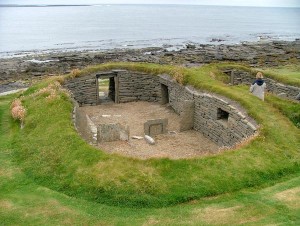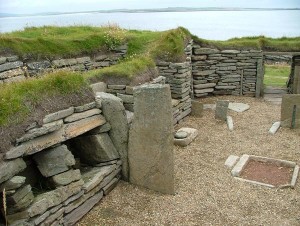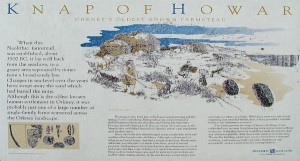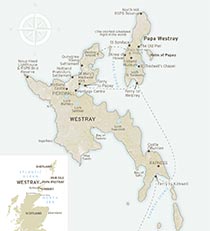 The Knap of Howar is not only one of the most significant archaeological sites in Orkney, but the site of the oldest standing houses in northern Europe. These two buildings are significantly older than the village at Skara Brae, and were inhabited from about 3800 BC by neolithic farmers who grew crops on the fertile land and raised cattle, sheep and a few pigs. The builders designed for maximum protection from the elements, digging down into the midden left by an earlier settlement so that the houses are invisible until you are almost standing on them. The long low entrance passageways sheltered the dwelling areas from the Orkney wind, and you can see the slots in the door-jambs at the inner end, for a bar to hold a door against the stone checks.
The Knap of Howar is not only one of the most significant archaeological sites in Orkney, but the site of the oldest standing houses in northern Europe. These two buildings are significantly older than the village at Skara Brae, and were inhabited from about 3800 BC by neolithic farmers who grew crops on the fertile land and raised cattle, sheep and a few pigs. The builders designed for maximum protection from the elements, digging down into the midden left by an earlier settlement so that the houses are invisible until you are almost standing on them. The long low entrance passageways sheltered the dwelling areas from the Orkney wind, and you can see the slots in the door-jambs at the inner end, for a bar to hold a door against the stone checks.

The interior of the larger house is partitioned by stone flags into two rooms, the outer one furnished with a stone sleeping platform and
the inner with a hearth and trough quern. A connecting passage leads to the smaller house which seems to have been the workshop and storage area, the innermost room lined with stone cupboards.
The Knap is not a village like Skara Brae but seems to have been the home of a single, virtually self-sufficient family unit. Excavation revealed bone and stone tools, and Unstan-ware pottery – quite different from the Grooved Ware used by the people at Skara Brae. As well as farming, the people of the Knap were highly competent deep-sea fishermen, and hunted sea-birds such as the Great Auk.
 [dopts id="6"]
[dopts id="6"] 
 Click for larger map
Click for larger map